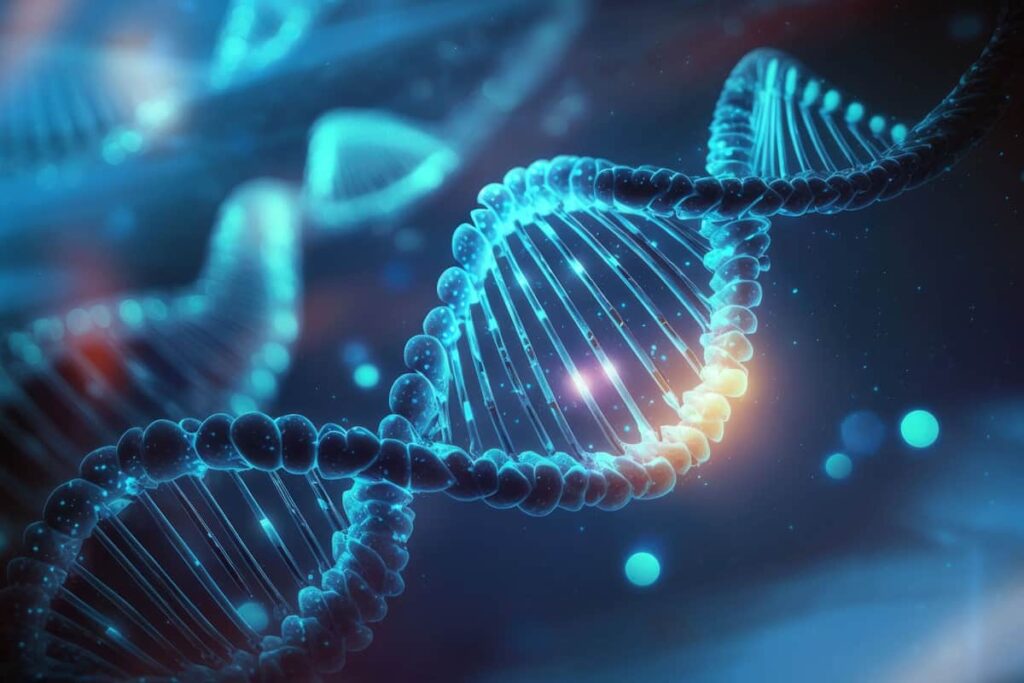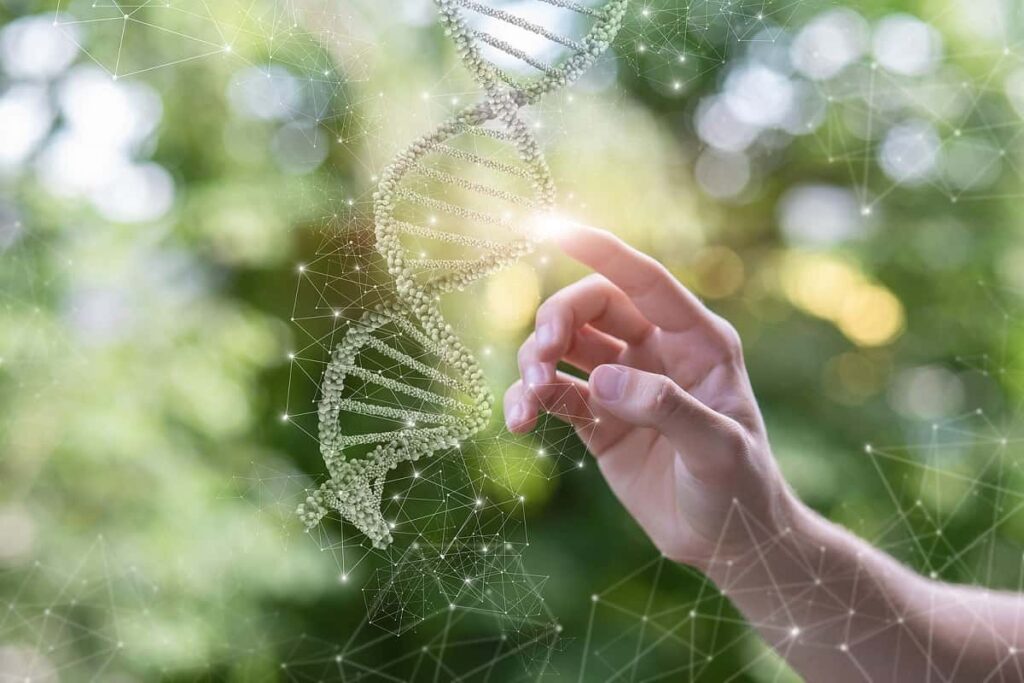How DNA Technology Enables Nanotechnology
Table of contents

As famous philosopher George Carlin used to remark, “Think about how stupid the average person is, and then realize that half of ’em are stupider than that.” One reason for the prevalence of stupidity is that mainstream conversation topics don’t revolve around anything intelligent, so we should hardly be surprised when only the nerdy kids are getting into Science, Technology, Engineering and Mathematics (STEM) classes. Maybe if we talked more about amazing scientific accomplishments instead of who is cheating on the Kardashians, then society would evolve into something that more closely resembles intelligent life. Fortunately, we may be one step closer to creating life that’s far more intelligent than what we see around us today. Scientists recently unveiled four new DNA letters, essentially doubling life’s alphabet. To understand what all this means, let’s start at the beginning.
The Building Blocks of DNA
As you probably know, your DNA represents something that is uniquely you. The recipe used to create who you are is all contained within a single strand of DNA that’s basically assembled using just four letters. From the National Human Genome Research Institute:
The four types of nitrogen bases found in nucleotides are: adenine (A), thymine (T), guanine (G) and cytosine (C). The order, or sequence, of these bases determines what biological instructions are contained in a strand of DNA. For example, the sequence ATCGTT might instruct for blue eyes, while ATCGCT might instruct for brown.
Using the above example, we can easily understand how we might use gene-editing tools to edit DNA at the germline and change a baby’s eyes from blue to brown (simply replace ATCGTT with ATCGCT.) We then might list out all hair colors possible and perhaps create some new ones. That’s easy to understand.
Now, think about all the things we might be able to change. The extent to which we can begin configuring DNA is mind-boggling given just how much information is stored in a single strand of DNA.

Now, think about this. What if we expanded those four letters (A,T,G,C) and gave you some additional ones to use as building blocks. You could then create some truly alien life forms.
Just last week, Nature published an article titled “Four new DNA letters double life’s alphabet,” which talks about how scientists have created for the first time “a synthetic, eight-letter genetic language that seems to store and transcribe information just like natural DNA.” The first thing investors might want to know is how this new breakthrough will translate into profits. One new field that’s being explored is something called “DNA nanotechnology.”
The Emergence of “DNA Nanotechnology”
In 2004, nanotechnology was all the rage, and we saw so much interest from investors that we could actually move low-float stock prices just by writing about them. Anyone who remembers that time will probably also remember companies like NVE Corporation or SkyePharma that were supposed to usher in a new era of “nano everything” where the world contains all these little nanobots that are doing productive things like curing cancer and cleaning up the environment. None of those promises have changed, they’ve just been labeled differently. We wrote about this in our article on a “Nanotechnology Definition for Investors in 2016,” which suggested that nanotechnology hasn’t gone anywhere, it just goes by different names now.

That’s why we still have a nanotechnology category on our site and consider synthetic biology to be a form of nanotechnology. What we haven’t talked about yet is something called “DNA nanotechnology,” which we came across in a recent paper published by some geniuses at Harvard – including none other than George Church himself – titled “From Designing the Molecules of Life to Designing Life: Future Applications Derived from Advances in DNA Technologies.” (At the top of the page, we see reference to a new term that’s been coined, “DNA Nanotechnology,” which refers to “forming artificial, designed nanostructures” using DNA modification technologies.)

“Due to the decrease in the cost of DNA synthesis and our understanding of the functional properties of various genetic elements, the behavior of entire cells can now be programmed to carry out specific operations,” says the report. Sounds an awful lot like the nanobots we envisioned, and the first part of the report dives into “How Advancements in DNA Synthesis Will Effect Nanotechnology,” and introduces us to something called “DNA origami.”
DNA Origami Nanostructures
Remember how the original promise of nanotechnology focused a lot on the ability for nanomachines to self-assemble? Well, in 2006, a method was designed that allows for the self-assembly of three-dimensional objects using DNA, and the report says that it is “now possible to design, create, and characterize a novel DNA nanostructure within a few weeks.” These nanostructures can be engineered to have unique properties making them ideal for things like drug delivery. The report talks about how they have “designed cancer-killing nano-robots” of the type we’ve been waiting for now for over a decade.

In order to build these nanobots at scale, we need “advancements in fundamental DNA synthesis technology” so that the cost of the raw materials can be brought down. That’s the sort of thing companies like Twist Biosciences (TWST) are working on. They produce synthetic DNA that can be used to fundamentally change the way that organisms operate.
Genomically Recoded Organisms (GROs)
The second section of the paper details a new era where we can use tools like gene editing to “recode” microbial genomes from bacteria to yeast, like what’s being done to create fake food. What we can then do is create organisms that have “the potential to enhance industrial production of chemicals and biologics.” (One company working in this space is Ginkgo Bioworks, which creates custom microbes for all sorts of applications, from developing organic pesticides to creating flavors and fragrances.)
In this section, the paper talks about how “Non-Standard Amino Acids (NSAAs)” can “expand the structural and functional diversity of proteins,” something that’s being worked on by a number of startups including Ambrx, GRO Biosciences, and Sutro. The report gives a few use cases for NSAAs – for example, to improve the catalytic properties of industrially relevant enzymes – but says it’s just the tip of the iceberg as to how we might use NSAAs.
The third section of the report expands further on the limitations of current gene-editing methods, and how we’re slowly moving “from learning the principles of putting together a genome to designing pipelines of building any genome of interest.” The ability to carve out genetic functionality is something we discussed in our article on “Genetic Circuit Engineering with Gene Editing.” Again, we can’t help but think of this whole thing as the emergence of Drexler’s Engines of Creation where we have god-like control over the structure of matter.
DNA Barcodes
The last section of the paper talks about how “DNA can also be repurposed to serve as molecular barcodes,” making you wonder how long it will be before someone tries to apply blockchain technology to the whole thing. (Actually, George Church is already two steps ahead of that idea with his startup, Nebula Genomics, which allows you to sell your DNA for cryptocurrency.) This function seems similar to how developers comment their code so that other developers can better understand it.
Expect to see an entire “standards” bureaucracy rise up around how you need to comment any GROs so that when the puddle of grey goo starts forming, we know who is responsible for cleaning it up.
A DNA Technology Stock
It was just over four years ago when we learned about how new DNA letters were being used for practical applications, and we wrote about how “Synthorx Takes Synthetic Life to a Whole New Level.” More recently, we wrote about them in our article on “6 Protein Engineering Startups Designing Biology” in which we discussed how Synthorx is adding the DNA letters X and Y so that cells can make proteins with up to 172 different amino acids versus the 20 amino acids created by Mother Nature which are called Standard Amino Acids (SSAs). Now, Synthorx is a publicly traded company.
Synthorx (THOR) debuted on the NASDAQ late last year and raised $131 million giving it a present-day market cap of around $640 million. The company’s “Expanded Genetic Alphabet” platform technology adds a new DNA base pair, X-Y, to the two naturally occurring base pairs, A-T and G-C, thereby artificially expanding the genetic code and allowing them to “create optimized biologics” which they refer to as Synthorins. They’re presently developing some cancer drugs that are designed to address shortcomings of existing treatments that don’t work so well.

Since these drugs are in early stages of development, the money Synthorx has raised through the IPO will help it with the expensive process of FDA approval. Synthorx is not the only firm that’s trying to play in this space, but certainly one of few publicly traded firms giving investors exposure to this theme.
Conclusion
It was Steve Jobs who once said that “the biggest innovations of the 21st century will be the intersection of biology and technology.” Seems about right, considering that now we can take entire cells and program them to carry out specific operations. It’s almost impossible to understate just how much progress has been made in DNA technology, and the paper refers to the “staggering” progress being made in gene editing – not to mention the cost to sequence DNA has dropped by one million-fold over the past three decades.
The next driver for DNA technology seems to be the “availability of inexpensive, long stretches of DNA.” One company that’s working on that is Twist Biosciences (TWST), and since they’re publicly traded as well, retail investors now have at least a few ways to get some exposure to the DNA technology theme. You can read more about the risks associated with that investment in our recent article on the Twist Biosciences IPO.
Sign up to our newsletter to get more of our great research delivered straight to your inbox!
Nanalyze Weekly includes useful insights written by our team of underpaid MBAs, research on new disruptive technology stocks flying under the radar, and summaries of our recent research. Always 100% free.















